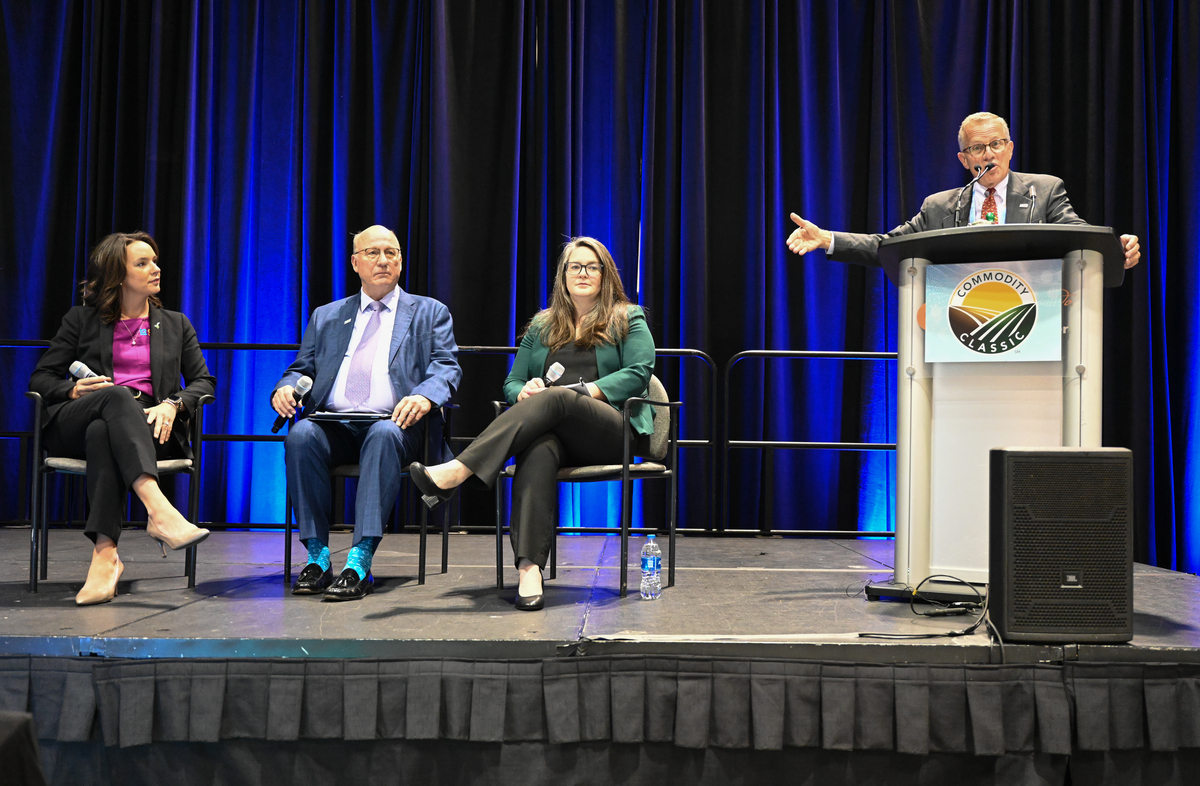
U.S. Soy sustainably nourishes consumers around the world. On March 10, during the 2023 Commodity Classic in Orlando, Florida, leaders from organizations that represent U.S. Soy explained how U.S. farmers and their soy checkoff investments produce sustainable soybeans that advance nutrition and local economies.
“U.S. farmers are doing well by doing good,” said USSEC CEO Jim Sutter. “U.S. Soy offers solutions to some of our most pressing global challenges.”
Sutter led a panel discussion focused on how implementing sustainability on farms links to food security, improved local economies and global access to U.S. Soy. The soy checkoff supports efforts that facilitate long-term demand for U.S. soybean products, a source of affordable, high-quality protein.
Growing Sustainability
Panel member Meagan Kaiser farms with her husband and his family near Carrollton, Missouri, works as a soil scientist and serves as the chair of the United Soybean Board Chair. She believes sustainability is intuitive to U.S. soybean farmers, and that it links directly to global food security.
She explained that farmers are continually improving, which is core to their sustainability. In college, she was taught that what is in the soil is in the plant, and then in the animal, and then in the human. She described practices that allow farmers to care for soils and crops to ensure they provide sustainable nutrition throughout those processes.
Kaiser shared her humanitarian obligation to produce crops to feed others. She also highlighted the value of soy for both sustainability and food security. Soy oil supports development of bio-based products, while soy protein feeds people and animals.
Building Food Security
U.S. Soy develops through the activities of the World Initiative for Soy in Human Health, or WISHH. Gena Perry, WISHH executive director, joined the panel to explain how efforts in 28 developing markets use soy to improve human health and nutrition, as well as food and feed security.
For example, in Cambodia, WISHH helped adapt the in-pond raceway system for aquaculture to the climate’s rainy and dry seasons. The organization works with a company in Rhode Island that uses soy in their food formulation to treat acute malnutrition. And in West Africa, WISHH ensures access to capital to develop soy-focused businesses. All these efforts strengthen local food security — and local economies.
As incomes rise, so does protein demand, and Perry described the importance of listening to what developing markets need and making connections to U.S. Soy to meet those needs. She cited the poultry industry in Ghana, which is benefiting from WISHH technical training about how to store soy for feed, as well as consumer education addressing myths about the nutritional value of eggs.
According to Perry, such work is the first step in providing access to U.S. Soy in diverse markets.
Increasing Global Access
Demand for U.S. Soy is growing, both because of its sustainability and nutritional value, according to Doug Winter, the immediate past chair of USSEC who farms near Mill Shoals, Illinois. As a member of the panel, he shared what he has heard from U.S. Soy customers.
“In my travels with U.S. Soy 10 years ago, the message focused on price,” he said. “However, in the last couple years, those conversations have shifted to focus on sustainability. Customers rank sustainability as the first or second factor in their purchasing decisions.”
Winter expects that in just three to five years, sustainability will be a higher priority than price in soy purchasing decisions. He noted that research innovations like breeding soybeans for a variety of characteristics allow U.S. farmers to maintain soy production despite climate variability. He stressed the value of communications and relationships built through both hosting trade teams on U.S. farms and participating in trade mission to meet with international customers.
“We’ve also seen the benefits of teaching other markets to produce better protein,” he added. “When we help local markets grow soybeans better, their overall soy demand grows, outpacing local production. Those markets turn to imports to meet demand. This increases local food security and demand for U.S. Soy.”
Winter heard and observed this trend in both Nigeria and Pakistan during the past year. He also believes that trendline yields in the U.S. will increase to supply both soy crush and whole soybean demand.
Together, Sutter, Kaiser, Perry and Winter detailed how U.S. Soy sustainably meets nutritional needs and supports progress of people and local economies around the world.

This article is partially funded by U.S. Soy farmers, their checkoff and the soy value chain.